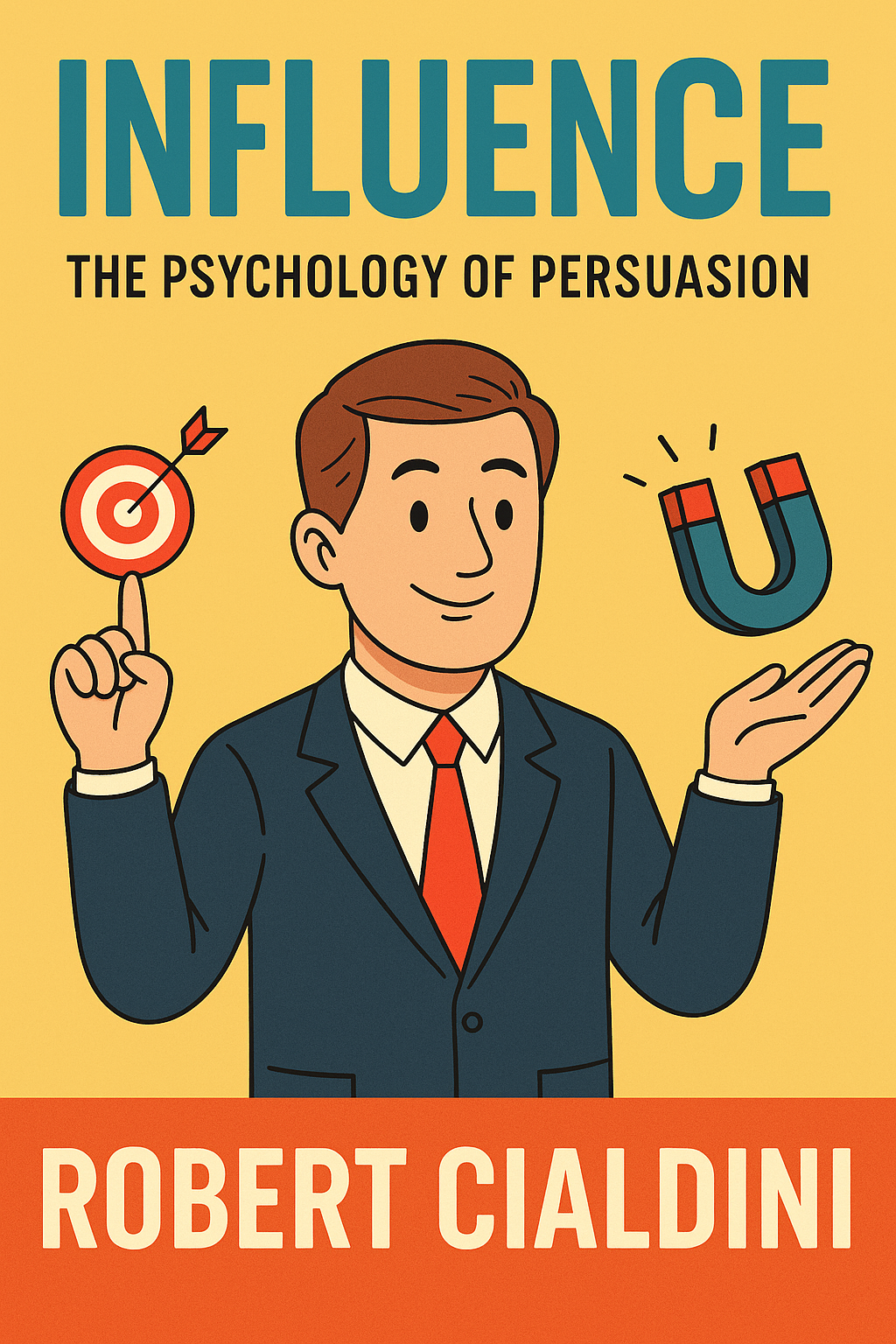🌟 INTRODUCTION: WHY YOU SAY “YES” WHEN YOU MEANT TO SAY “NO”
Have you ever bought a random gadget after watching a late-night infomercial? Or nodded to something in a meeting even though you knew it didn’t make any sense? Welcome to the world of persuasion — the real world Jedi mind tricks that influence our decisions daily.
In this Influence: The Psychology of Persuasion summary, Dr. Robert Cialdini breaks down the science behind why people say “yes” and how to defend yourself against being manipulated. This book is a treasure for marketers, salespeople, negotiators, and anyone seeking to understand human behaviour.
Let’s dive into the six principles of persuasion that rule your brain without you even realising it. If you’re wondering how to persuade people ethically and effectively, Cialdini’s principles are the ultimate guide.
🔄 PRINCIPLE #1: RECIPROCITY
“You owe me one.”
Humans are hardwired to return favours. Does someone give you a free sample? You feel like you should make a purchase. A coworker covers your shift? You feel obligated to return the favour.
Cialdini explains that even small, volunteered gifts or gestures can create a powerful feeling of obligation.
🔧 Example:
- A waiter gives you a mint with your bill. Tips go up.
- Add two mints? Tips skyrocket. Coincidence? No. Psychology.
🔐 How to use it:
Offer value first. Give before you ask. But don’t be fake—humans can smell insincerity like a bad perfume.
🌟 PRINCIPLE #2: COMMITMENT AND CONSISTENCY
“As soon as we agree, we prefer to remain committed.”
We all want to be consistent with our actions, especially if we commit to something publicly.
🔧 Example:
- Encouraging an individual to document their objective increases the chances of them achieving it.
- Asking customers to sign a petition first increases their chances of donating later.
🔐 How to use it:
Start with small asks (foot-in-the-door technique). Build momentum. Consistency kicks in.
🔍 PRINCIPLE #3: SOCIAL PROOF
“If everyone else is doing it, it must be the right thing.”
We often look to others for guidance in making decisions, especially in uncertain situations. This is why you check restaurant reviews before dining in or why you pick the crowded food stall at a market.
🔧 Example:
• “Best-seller” labels on products
🔐 How to use it:
Use testimonials, reviews, and user stats. Show that others like you have made the same decision.
❤️ PRINCIPLE #4: LIKING
“We say yes to people we like.”
We tend to trust people we find attractive, similar to, or who pay us compliments. Like it or not, we’re more likely to be persuaded by people we like.
🔧 Example:
- Tupperware parties (your friend sells, so you buy)
- Influencers who “feel” like friends
🔐 How to use it:
Build rapport. Be relatable. Compliment genuinely. Mirror language and interests.
🔑 PRINCIPLE #5: AUTHORITY
“Because the expert said so.”
People tend to obey figures of authority. This can be a doctor, a person in uniform, or even someone with a fancy job title.
🔧 Example:
- Actors dressed as doctors in ads
- Professionals displaying diplomas on their office walls
🔐 How to use it:
Establish credibility. Show credentials, years of experience, or client testimonials. This is one of the main points to remember from this Robert Cialdini summary.
🔒 PRINCIPLE #6: SCARCITY
“Limited-time offer!”
People want more of what they perceive they be in limited supply. Scarcity creates urgency. We fear missing out.
🔧 Example:
- “Only 3 seats left!”
- 50 per cent off, limited editions
🔐 How to use it:
Highlight what’s unique. Use deadlines. Show demand. But never fake it.
BONUS CHAPTER: DEFENSE AGAINST MANIPULATION
Cialdini doesn’t just want to turn you into a persuasion wizard. He also wants to help you avoid being manipulated. The trick? Pay attention to how you feel when you’re about to say yes.
If you feel rushed, anxious, or like you “owe” something, pause. That’s likely one of the six principles being weaponised. This isn’t just about persuasion; it’s also about mastering the psychology of influence.
📓 TABLE: 6 PRINCIPLES OF PERSUASION
| Principle | What It Means | How It Works |
|---|---|---|
| Reciprocity | We return favors | Give before you ask |
| Commitment | We stick to our words | Get small commitments first |
| Social Proof | We follow others | Show testimonials and reviews |
| Liking | We say yes to people we like | Build rapport, find similarities |
| Authority | We trust experts | Display autority and experience |
| Scarcity | We want what’s rare | Use urgency and exclusivity |
📈 FINAL THOUGHTS: BE PERSUASIVE (NOT PUSHY)
This book summary of Influence by Cialdini is a masterclass in understanding human behaviour. Whether you’re selling a product, pitching an idea, or trying to convince your toddler to eat broccoli, these principles work across all areas of life.
But with great influence comes great responsibility. Use it wisely. Respect your audience. Be ethical. And most importantly, be aware of when others are using it on you.
Because now? You know the playbook.
